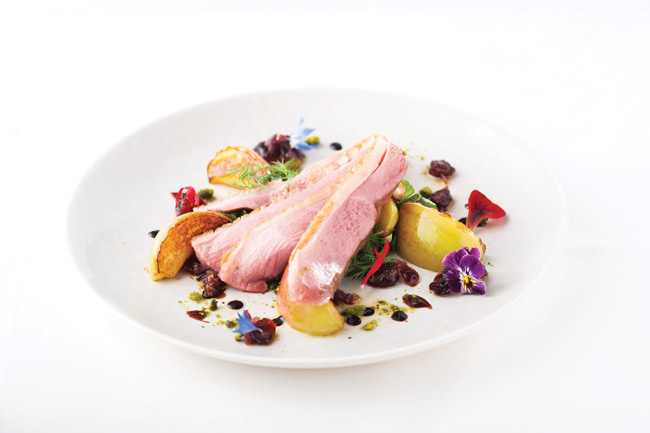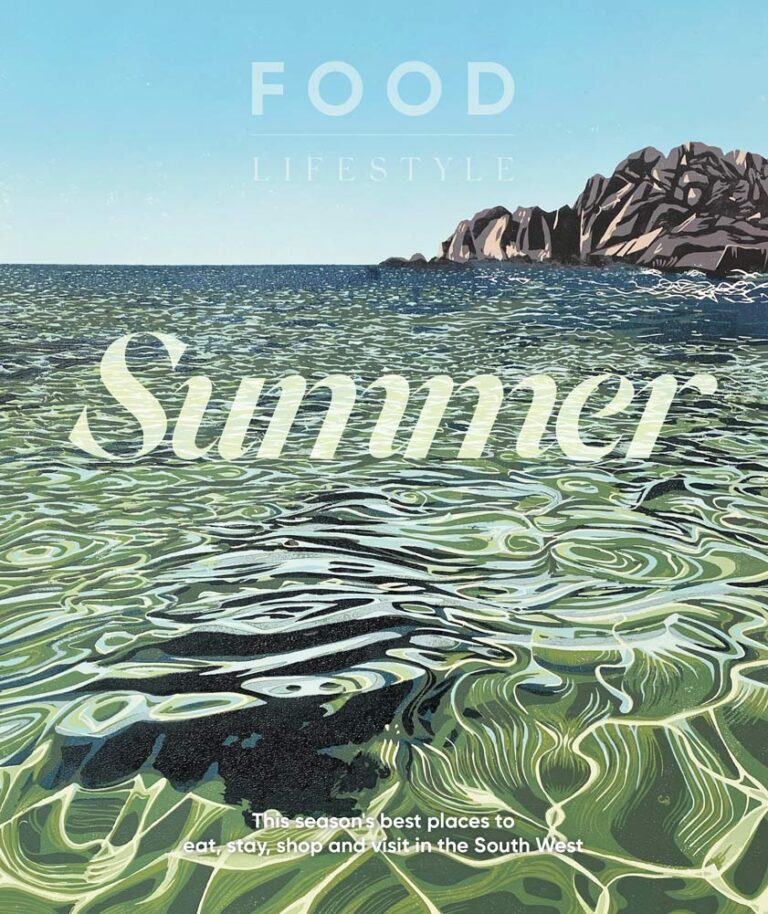Roasted duck with caramelised apples
Darrin Hosegrove of Ashburton Cookery School shares his recipe for duck with caramelised apples

Save any excess duck fat from this delicious dish by Darrin Hosegrove of Ashburton Cookery School for the ultimate roasties
www.ashburtoncookeryschool.co.uk
Serves 2
Oven temp 220°c / gas 6
Sladesdown duck breast 1
For the dressing:
- Shallot ½, finely chopped
- Olive oil 100ml
- Raspberry vinegar 40ml
- Clear honey 1tsp
- Dried cranberries 1 tbsp, chopped
- Sea salt and cracked black pepper
For the caramelised apples:
- Eating apple 1, Cox’s or Braeburn
- Unsalted butter 10g
- Brandy splash
- Caster sugar 1 tsp
- For the dressing: gently sweat the shallot in a little of the olive oil until softened. Add the raspberry vinegar and simmer to reduce by half.
- Add the honey and cranberries while still warm and allow the reduction to cool slightly. Stir through the remaining olive oil. Add a splash of water and seasoning. Taste, add more seasoning or honey if necessary and serve at room temperature.
- For the duck breast: score the fat on the duck breast with a sharp knife in a criss cross pattern. Season well with salt on both sides, and place into a cold frying pan with no oil.
- Gently render the fat down from the duck breast in the frying pan on a medium heat for 5–6 minutes. Pour away any excess fat.
- Seal the other side and then place the duck into a hot oven skin side down for 6–8 minutes at 220°c / gas 6 or until the duck breast is medium rare. Rest for 5 minutes before carving.
- For the caramelised apples: peel the apple, cut into quarters and remove the core. Cut each quarter into 3 equal wedges. Place the butter in a frying pan over a high heat and wait for it to turn nut brown in colour.
- Add the apples straight away before the butter burns and saute over a slightly lower heat until the apples start to colour. Add a splash of brandy and flame the apples to burn off the alcohol. Add the caster sugar and continue to turn the apples in the pan until caramelised.
Supported by
You will need
Sladesdown duck breast 1
For the dressing:
- Shallot ½, finely chopped
- Olive oil 100ml
- Raspberry vinegar 40ml
- Clear honey 1tsp
- Dried cranberries 1 tbsp, chopped
- Sea salt and cracked black pepper
For the caramelised apples:
- Eating apple 1, Cox’s or Braeburn
- Unsalted butter 10g
- Brandy splash
- Caster sugar 1 tsp
Method
- For the dressing: gently sweat the shallot in a little of the olive oil until softened. Add the raspberry vinegar and simmer to reduce by half.
- Add the honey and cranberries while still warm and allow the reduction to cool slightly. Stir through the remaining olive oil. Add a splash of water and seasoning. Taste, add more seasoning or honey if necessary and serve at room temperature.
- For the duck breast: score the fat on the duck breast with a sharp knife in a criss cross pattern. Season well with salt on both sides, and place into a cold frying pan with no oil.
- Gently render the fat down from the duck breast in the frying pan on a medium heat for 5–6 minutes. Pour away any excess fat.
- Seal the other side and then place the duck into a hot oven skin side down for 6–8 minutes at 220°c / gas 6 or until the duck breast is medium rare. Rest for 5 minutes before carving.
- For the caramelised apples: peel the apple, cut into quarters and remove the core. Cut each quarter into 3 equal wedges. Place the butter in a frying pan over a high heat and wait for it to turn nut brown in colour.
- Add the apples straight away before the butter burns and saute over a slightly lower heat until the apples start to colour. Add a splash of brandy and flame the apples to burn off the alcohol. Add the caster sugar and continue to turn the apples in the pan until caramelised.
You may also like
